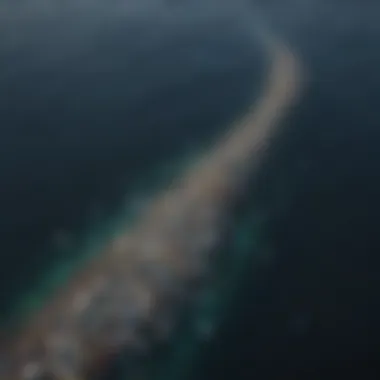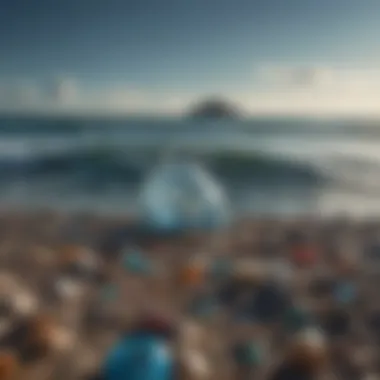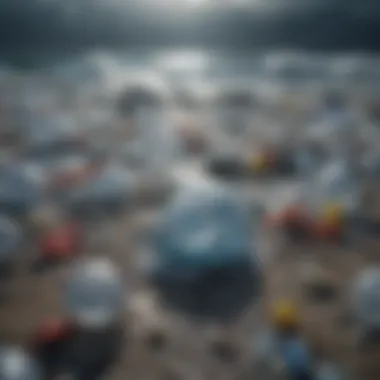Addressing the Great Atlantic Garbage Patch


Intro
The Great Atlantic Garbage Patch is a pressing issue that has garnered increasing attention in recent years. This accumulation of debris, primarily composed of plastic, poses significant threats to marine ecosystems, human health, and economic activity. Understanding its origins, composition, and the far-reaching consequences of this environmental challenge is critical for effective action.
The problem did not emerge overnight. It is the result of decades of improper waste management, overconsumption, and a lack of awareness regarding the consequences of plastic pollution. These issues intertwine with socio-economic factors that affect communities and industries worldwide.
Many may ask why this debris matters. The implications are far-reaching. Marine life suffers from entanglement, ingestion of plastics, and habitat disruption. Communities reliant on fishing industries face economic challenges as fish populations decline. Moreover, the widespread visibility of plastic pollution can significantly affect tourism, leading to diminished economies in coastal areas.
To address this crisis, innovative solutions are being explored. From cleaner production techniques to advanced recycling methods, the call for action rings louder than ever. It emphasizes the importance of understanding the Great Atlantic Garbage Patch to develop strategies that can mitigate its detrimental effects.
Preface to the Great Atlantic Garbage Patch
The Great Atlantic Garbage Patch is not just a swath of debris floating in the ocean; it is a complex and pressing environmental issue that encapsulates the broader crisis of plastic pollution in our waterways. Understanding this patch is crucial for several reasons. Firstly, it reveals the scale of marine litter and highlights human impact on ocean health. Secondly, it serves as a reminder of the interconnectedness of ecosystems and how pollution can adversely affect not only marine life but also human societies.
Environmentalists, researchers, and policymakers emphasize the need to address this issue. The implications extend beyond ecology; they touch on economic aspects, public health, and social responsibility. With increased attention from both the scientific community and the general public, it is vital to dissect the facets of this garbage patch and explore the potential solutions.
Defining the Garbage Patch
The term "garbage patch" might create an impression of a solid mass of waste. In actuality, it is more like a soup of tiny particles, predominantly consisting of plastics. These particles vary in size, from large pieces of debris to microscopic fragments known as microplastics. Unlike visible trash, much of this debris lies below the ocean's surface, making it difficult to quantify and clean. This less-visible aspect complicates efforts to address the pollution effectively.
Geographical Location and Size
The Great Atlantic Garbage Patch is located primarily between the Bermuda Triangle and the Caribbean Sea. This vast area is part of the North Atlantic subtropical gyre, a circular ocean current that traps debris. Its size is astonishing, estimated to span over thousands of square miles. The patch's size can fluctuate due to weather patterns and ocean currents, but the concerning reality is that it is continuously growing.
Historical Context
The issue of marine debris is not new. It stems from decades of societal negligence toward waste management. The rise of mass consumerism, particularly after World War II, led to an explosion of plastic use. Many products that were once intended for single use began to accumulate in our oceans. As global shipping grew and maritime activities expanded, so did the potential of ocean pollution. The first documented evidence of a garbage patch in the North Atlantic came in the 1970s, marking the beginning of a more systematic study of oceanic litter, which has only become a focal point of environmental research in recent decades.
Composition of the Patch
The composition of the Great Atlantic Garbage Patch is fundamental to understanding its environmental impact. Knowing what constitutes this accumulation of debris helps in assessing its ecological effects. Specifically, identifying the types and sources of debris can guide mitigation strategies. In this section, we will examine the various elements that make up the patch, emphasizing their contributions and implications for marine ecosystems.
Types of Debris
Plastic
Plastic is the most pervasive material found in the Great Atlantic Garbage Patch. Its durability and resistance to degradation are key characteristics that contribute to its prevalence. It accounts for a large portion of marine debris, posing significant risks to wildlife and ecosystems. One major advantage of plastic is its wide range of uses, from packaging to fishing gear. However, its resilience also means it can persist in the ocean for centuries. This long lifespan leads to the fragmentation of plastic into smaller pieces, known as microplastics, exacerbating the pollution problem.
Fishnets and Fishing Gear
Fishnets and fishing gear are another significant component of the patch. Often termed "ghost gear," these items are discarded or lost at sea and can continue to trap marine life. The key feature of fishnets is their ability to entangle animals, which directly impacts biodiversity. Ghost gear can trap fish, seabirds, and mammals, leading to suffering and depletion of marine populations. While fishing gear serves a crucial role in the fishing industry, its abandonment at sea represents a major concern for marine conservation in this article.
Microplastics
Microplastics, tiny plastic particles less than five millimeters in size, are a critical concern within the garbage patch. They originate from the breakdown of larger plastic items and are often ingested by marine organisms. The key characteristic of microplastics is their ability to absorb harmful chemicals from the environment, which can further contaminate the food chain. Their small size allows them to penetrate various ecosystems, making removal and control very challenging. Microplastics highlight the interconnectedness of pollution and ecological health that needs addressing in this article.
Sources of Pollution
Understanding the sources of pollution is vital for developing effective solutions to reduce waste in the ocean. Each source contributes differently to the overall composition of the patch, and identifying these helps prioritize response efforts.
Land-based Sources
Land-based sources play a significant role in the pollution of the Great Atlantic Garbage Patch. These sources include littering, runoff, and waste management issues. A key characteristic of land-based pollution is its direct relationship to human activities. Cities near coastlines often have inadequate waste disposal systems, leading to debris ending up in the ocean. While awareness campaigns can mitigate some instances of pollution, the connection between urban development and environmental degradation remains challenging.
Marine Activities


Marine activities, including tourism and fishing, contribute to ocean debris as well. Fishing vessels often discard unwanted catch and waste, while tourists may inadvertently leave behind plastics. A key aspect of marine activities is their dual nature; they support economic development but can impose risks on marine ecosystems. Balancing these interests is difficult, especially when marine health is compromised by such practices. Maintaining sustainable methods of tourism and fishing is essential in tackling the pollution crisis.
Shipping and Commercial Vessels
Shipping and commercial vessels are significant contributors to marine debris as well. These ships often discard waste, including plastics, directly into the ocean. The key feature of this issue is the volume of these operations; large vessels transport goods globally, and even a small percentage of waste can accumulate to substantial amounts in the ocean. Regulations exist, but enforcement varies by country. Addressing waste management on commercial vessels is critical to minimize their impact on the Great Atlantic Garbage Patch.
Ecological Impact
The ecological impact of the Great Atlantic Garbage Patch is substantial and cannot be overlooked. This section examines the various ways in which marine debris, particularly plastic, affects the ocean's ecosystems. It highlights important connections between pollution and marine life, underscoring the implications for biodiversity and ecosystem health.
Effects on Marine Life
Entanglement and Ingestion
One of the most immediate effects of marine debris on marine life is through entanglement and ingestion. Animals can become trapped in abandoned fishing gear or plastic waste. This leads to injury or death. Entanglement restricts movement, making it hard for the organism to feed or escape predators. Ingestion occurs when animals mistake plastic for food, causing internal injuries, malnutrition, or even starvation. This aspect is crucial as it directly links human waste to animal suffering.
Key characteristics of entanglement and ingestion include their high incidence rates across various species. Sea turtles and seabirds are often affected, which makes this a notably relevant point in the study of marine debris. The unique feature is that these occurrences can lead to a rapid decline in species, highlighting the urgent need for targeted measures against ocean pollution. The disadvantage here is that while public awareness is growing, the solutions often require time and resources that are still lacking in various regions.
Biodiversity Loss
The biodiversity of ocean ecosystems is greatly impacted by pollution from the Great Atlantic Garbage Patch. The loss of marine species disrupts food chains and reduces genetic diversity. This aspect highlights how interconnected marine life is; the decline in one species can affect others, leading to a cascading effect on the entire ecosystem.
Biodiversity loss is a pressing concern because it threatens not only marine species but also the health of ocean ecosystems upon which human societies rely. Unique features of this impact include the long-term ecological changes that can occur, which might not be reversible. Though awareness campaigns are increasing, they often do not lead to immediate corrective actions, demonstrating a gap between knowledge and implementation.
Chemical Pollution
Chemical pollution is another critical element linked to the Great Atlantic Garbage Patch. Plastics break down into microplastics, which can absorb toxins from the surrounding water. These chemicals enter the food chain when consumed by marine organisms, potentially affecting human health as well. The implications for reproductive health, growth, and development in both marine species and humans cannot be underestimated.
Key characteristics of chemical pollution include the persistence of pollutants that can remain in ecosystems for years. Importantly, the unique feature of this pollution is its hidden nature; many toxins do not produce immediate visible effects, allowing pollution to continue relatively unnoticed. The disadvantages are clear: clean-up and regulation of these pollutants can prove challenging without robust policies and practices in place.
Impact on Ecosystem Health
The overall ecosystem health is being diminished by the myriad of impacts stemming from the Great Atlantic Garbage Patch. With ongoing pollutants affecting the physiological conditions of marine species, the balance of ecosystems is at risk. This section will outline various aspects of ecosystem health already impacted, illustrating the profound interconnections at play and how marine pollution disrupts these vital systems.
Socio-Economic Ramifications
The socio-economic ramifications of the Great Atlantic Garbage Patch provoke significant concern among various stakeholders. Understanding these implications is critical not only for environmentalists but also for communities, policymakers, and industries reliant on aquatic resources. The economic impact of marine debris extends beyond mere aesthetics; it affects fisheries, tourism, and public health in profound ways.
Effects on Fisheries
Fisheries are deeply impacted by the presence of the garbage patch. Marine debris, especially plastic and discarded fishing gear, can entangle fish and marine species. This results in a decline of populations, which directly affects the fishing industry. Many fishermen have reported lower catches, leading to economic strain and uncertainty. The effects ripple through local economies where fishing is a primary livelihood. Additionally, contaminated fish pose health risks, discouraging consumers and reducing market demand.
- Decline in fish populations due to ingestion or entanglement.
- Consequences for fishermen include reduced income and increased operational challenges.
- Consumer concerns about safety create potential market declines.
Tourism and Coastal Communities
Coastal tourism thrives on clean beaches and healthy marine environments. The presence of debris not only disturbs the natural beauty but also deters tourists. Reports detail a noticeable drop in visitor numbers in regions affected by marine debris. Coastal businesses, including hotels and restaurants, feel financial pressure as bookings dwindle. Community engagement in beach clean-ups can foster a sense of responsibility, but consistent pollution undermines public interest in these activities.
- Deterioration of beach conditions leads to fewer tourists.
- Impacts on local businesses relying on tourist spending.
- Community efforts often fall short against continual pollution challenges.
Public Health Concerns
Public health emerges as another critical issue associated with the Great Atlantic Garbage Patch. Microplastics, which are prevalent in the patch, can infiltrate the food chain. Studies indicate that marine species ingest these plastics, which then find their way into human diets. This raises alarming questions about the long-term health effects of consuming contaminated seafood. Furthermore, beach pollution can foster unsafe recreational environments, leading to injuries or illness from sharp debris and pollutants.
- Potential health risks from microplastics and contaminated seafood consumption.
- Increased accidents on polluted beaches pose immediate health threats.
- Community health implications necessitate greater awareness and monitoring.
The Great Atlantic Garbage Patch serves as a critical indicator of our oceans' health and reflects wider systemic issues related to pollution, resource management, and economic stability. Addressing these socio-economic ramifications necessitates a multifaceted approach involving community action, legislative measures, and educational initiatives.


Mitigation Efforts
The issue of plastic pollution in the oceans has gained global attention. The Great Atlantic Garbage Patch serves as a strong symbol of this crisis. Mitigation efforts aim to reduce and, if possible, eliminate marine debris. These efforts are vital for maintaining ecosystem balance and protecting marine life. Moreover, they foster community engagement and awareness. By incorporating effective strategies, stakeholders can collectively work towards reversing the damage caused by pollution.
Current Cleanup Initiatives
NGOs and Volunteer Efforts
Non-governmental organizations play a significant role in tackling marine debris. They often lead grassroots efforts to organize cleanup activities. The key characteristic of these efforts is their collaborative nature. Volunteers from diverse backgrounds participate, raising awareness while removing debris from beaches and waterways.
One notable initiative is the Ocean Conservancy’s Coastal Cleanup Day. It mobilizes thousands of individuals worldwide to collect trash. This event not only highlights the issue but also creates a sense of community responsibility. The unique feature of NGOs is their ability to adapt quickly and address local needs effectively.
Advantages of these efforts include:
- Increased public awareness about marine debris.
- Immediate removal of pollution from affected areas.
- Community engagement through volunteerism.
However, challenges remain. Limited funding and resources often restrict the scale of these initiatives.
Government Interventions
Government interventions are crucial in establishing a formal framework for ocean clean-up. These interventions can include regulations and funding support for research and cleanup initiatives. One critical feature is the integration of scientific research with policy-making. This ensures that actions taken are informed by data and analysis.
For instance, the U.S. federal government has introduced the National Oceanic and Atmospheric Administration (NOAA) initiatives to monitor and manage marine debris. The use of structured policies helps streamline cleanup processes and allocate resources effectively.
The government also engages with communities through education programs and awareness campaigns. Some advantages of government interventions are:
- Structured approaches to managing pollution.
- Access to funding for significant cleanup operations.
- Creation of long-term policies to prevent future pollution.
However, bureaucracy can sometimes slow down response times. The effectiveness of these efforts can vary significantly based on political willingness and public priorities.
Legislative Framework
Legislation is foundational in shaping how societies address environmental challenges. A robust legislative framework helps establish clear guidelines and responsibilities for stakeholders. This framework includes international and local initiatives that aim to curb marine debris.
Initiatives by International Bodies
Various international organizations focus on ocean health. The United Nations and Humanity’s Ocean initiatives play vital roles. Their key characteristic is the emphasis on collaboration among nations. This facilitates a unified response to transboundary environmental issues.
For example, the MARPOL treaty seeks to minimize pollution from ships. These international initiatives encourage member states to implement national policies that align with global environmental goals. The advantage of these efforts is the pooling of resources and expertise, allowing for comprehensive solutions.
However, international agreements may face challenges in enforcement and compliance among different nations.
Local Government Policies
Local governments have a direct impact on managing marine litter. They establish ordinances and programs tailored to their communities' needs. One significant feature is the ability to enact immediate regulations. Local governments can quickly respond to pollution events by implementing bans or restrictions on single-use plastics.
Many coastal towns have adopted initiatives to promote beach cleanups and educational programs, targeting residents and visitors. These local policies can be highly advantageous because they cater specifically to regional issues and leverage local values.
However, local efforts may lack the necessary funding or manpower to be as effective as larger scale initiatives. Without broader support, these localized actions may not enough to significantly alter the state of marine debris.
> Gathering community input on clean-up strategies enhances both effectiveness and sustainability.
Innovative Solutions
Innovative solutions are crucial in addressing the challenges posed by the Great Atlantic Garbage Patch. These solutions represent a blend of technological advancements and community engagement that are essential for long-term sustainability. The effectiveness of these strategies can not only lead to the cleanup of existing debris but also foster a culture of stewardship towards marine environments. By exploring these avenues, we are not just responding to a current crisis; we are actively preventing future pollution.
Technological Advancements


Autonomous Cleanup Drones
Autonomous cleanup drones have emerged as a promising tool for tackling marine debris. These drones are designed to explore vast ocean areas while efficiently collecting waste. One key characteristic is their ability to operate independently, reducing the need for human intervention. This makes them a practical choice for areas that are difficult to access.
One unique feature of these drones is their integration of advanced navigation systems, which allows them to scout for debris in real-time. This characteristic enhances their effectiveness. Yet, challenges exist, such as high operational costs and dependence on battery life, which can limit their range. Overall, autonomous cleanup drones highlight the potential of technology in mitigating pollution issues within our oceans.
Bioremediation Techniques
Bioremediation techniques are also gaining traction as a solution to plastic pollution. This approach uses microorganisms to break down pollutants naturally. The key characteristic of bioremediation is its eco-friendly nature, as it employs biological processes rather than chemical solutions. This aspect makes it a favorable choice for reducing marine debris.
A unique feature of bioremediation is its adaptability; it can be tailored to target specific types of pollutants. However, there are disadvantages, including the time required for effective results and dependency on environmental conditions. Despite these challenges, bioremediation techniques present an innovative method for approaching the complexities of plastic pollution in marine environments.
Community Involvement and Education
Awareness Campaigns
Awareness campaigns play an essential role in mobilizing public support for ocean cleanup efforts. These campaigns aim to educate people on the issues associated with the Great Atlantic Garbage Patch and foster community engagement. A key characteristic of these campaigns is their ability to reach diverse audiences through various platforms, making the topic accessible to all age groups.
Unique features of effective awareness campaigns include interactive elements, such as social media initiatives that encourage sharing. They leverage grassroots movements, which can lead to substantial community involvement. However, one of the challenges is maintaining momentum over time and ensuring consistent engagement. Overall, awareness campaigns serve as a vital component in prompting collective action towards cleaner oceans.
Citizen Science Projects
Citizen science projects are another innovative solution that encourages public participation in environmental monitoring. These projects invite volunteers to collect data, which helps scientists better understand the scope of pollution. A standout characteristic of citizen science is its ability to promote a sense of ownership and responsibility among participants. This engagement is beneficial for fostering a deeper connection to marine ecosystems.
The unique feature of such projects is their collaborative nature, allowing individuals to contribute meaningfully to scientific research. However, potential drawbacks include varying levels of data quality, depending on participant training. Despite these issues, citizen science projects represent an effective way to harness community power in the fight against marine debris.
Future Directions
The future of addressing the Great Atlantic Garbage Patch hinges on a multifaceted approach that integrates science, policy, technology, and community action. This section emphasizes the critical importance of future directions in this fight against plastic pollution. Understanding where we might be headed allows for strategic planning and mobilization of resources in the upcoming years.
Research Gaps
Identifying and filling research gaps is essential for evolving our understanding of the Great Atlantic Garbage Patch. Current studies highlight the extent of plastic pollution, but there are still unknowns about several aspects:
- Ecological Impact: The long-term ecological effects of plastics on marine ecosystems need further exploration. Particularly, how microplastics affect the food chain has not been sufficiently studied.
- Material Degradation: There is a need for deeper insights into how different types of plastics degrade in oceanic environments over time. Understanding the processes involved can inform better material choices in manufacturing and waste management.
- Human Health: The implications of marine pollution on human health, especially for those consuming seafood, lacks comprehensive studies. This connection must be explored to fully understand the societal impacts.
Filling these research gaps will provide crucial data to inform policy decisions, remediation strategies, and to raise public awareness effectively.
Policy Recommendations
To combat the challenges presented by the Great Atlantic Garbage Patch, concrete and actionable policy recommendations must be established. These policies should focus on:
- International Collaboration: It is imperative to foster global cooperation among nations. As ocean currents do not recognize borders, a united front at international bodies, like the United Nations, can elevate regulations and funding for cleanup initiatives.
- Stricter Regulations: Governments should enforce stricter regulations on plastic production and disposal. Implementing deposit-return schemes and banning single-use plastics can significantly reduce new inputs into marine environments.
- Funding for Research: Increased funding should be allocated to research institutions focused on marine pollution. Governments and private sectors must invest in grants for scientists studying the impact of plastics and developing new materials.
- Community Engagement Initiatives: Policies must include grassroots initiatives. Educating communities about the importance of reducing plastic use and providing platforms for community-led cleanup efforts can shift public narratives and behaviors.
Future directions hinge on comprehensive strategies aimed at closing the gaps in knowledge and legislation that currently hinder effective action.
"In understanding the Great Atlantic Garbage Patch, we face an intricate web of environmental and policy challenges that demand immediate action and innovative solutions."
Culmination
The significance of understanding the Great Atlantic Garbage Patch cannot be overstated. This environmental phenomenon encapsulates critical challenges that affect not only marine ecosystems but also human societies. Addressing this issue entails a multifaceted approach that combines scientific research, community engagement, and legislative action.
Summary of Findings
The Great Atlantic Garbage Patch represents a colossal accumulation of marine debris, predominantly plastics. Studies show that billions of pounds of plastic enter the ocean annually, leading to significant ecological repercussions. The patch not only threatens marine biodiversity but also poses economic threats to industries like fishing and tourism. Mitigation efforts have gained momentum, with innovative cleanup technologies and increased public awareness showing promise. However, significant gaps in research and policy remain, emphasizing the need for ongoing collaboration among stakeholders.
Call to Action
The final point is a call for collective action. For individuals, that means reducing personal plastic consumption and participating in local cleanup efforts. Policymakers must prioritize stronger regulations against plastic waste. Educators and community leaders should focus on raising awareness about the environmental impact of plastic pollution. In bringing together the diverse capabilities of society, we can combat this pressing issue and promote a sustainable future. As highlighted in various studies, integrating community action with innovative solutions holds the key to effectively addressing the Great Atlantic Garbage Patch.
"The realization of our collective responsibility towards the ocean can guide us toward a more sustainable relationship with our environment."
By synthesizing the information presented, we see a clear path forward. The complexities of the Great Atlantic Garbage Patch necessitate urgent and informed responses to ensure the health of our oceans and the well-being of future generations.







